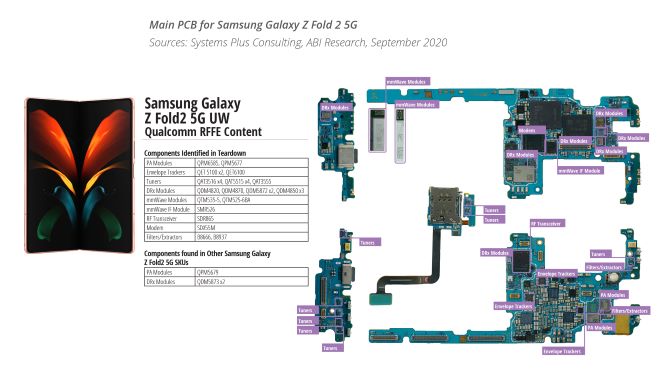Teardowns Of New 5G Smartphones Confirm Benefits Of Integrated Radio System Design
OYSTER BAY, NY -- Smartphone OEMs are extending fully integrated modem-RF system designs to support 5G and LTE implementations over their flagship devices, a new teardown analysis says.
ABI Research and System Plus Consulting determined the the development by unpacking two 5G smartphones from Samsung, the Galaxy Note 20 5G and the Galaxy Z Fold 2 5G.
The study shows that Qualcomm’s RFFE system design covers both sub-6GHz and millimeter wave (mmWave) 5G options, as well as LTE frequency bands, which will enable OEMs to efficiently and cost-effectively integrate 5G with 3G/4G into complex form factors. Such a fully integrated modem-RF system design is vital to drive wider adoption of 5G beyond the traditional smartphone market.
“Of particular interest in these teardowns is the use of mmWave modules, which are showing signs of increasing adoption as they aim to reach markets beyond North America. The use of these modules will be even more crucial for enabling new and complex form factor designs, such as foldable phones, to support mmWave access,” said David McQueen, research director, ABI Research.
With 5G smartphone sales expanding rapidly, the RFFE has now replaced the modem/chipset as the largest revenue growth opportunity in the industry. “High design and RF components sourcing complexity are evident in 5G, so smartphone OEMs are seeking to favor integrated system solutions to accelerate time to market while differentiating in terms of performance and overall power consumption,” McQueen explains. “Optimizing integration between 3G/4G and 5G using a single supplier could not only provide a superior system design, enabling the production of cost-effective, smaller form factors, and low-power consuming devices, but it also has the potential to support newer features, such as 5G Carrier Aggregation (CA) and Dynamic Spectrum Sharing (DSS). Furthermore, 5G mmWave ecosystem momentum is gathering pace as the complexity of integration in smartphones is addressed through a fully integrated and miniaturized mmWave RF module design, which appears to have already matured enough to support ultra-thin foldable smartphone designs.”
Handling the complexity of the entire cellular radio systems for OEMs can only be achieved if the modem-to-antenna system as a whole is taken into consideration, including co-existing mmWave/sub-6 RFFEs.

“However, these latest teardowns suggest signs in the industry that this approach has expanded to encompass an optimized design that now includes 4G,” McQueen points out. OEMs cannot ignore this level of integration to rationalize RFFE procurement. “Moreover, this approach ensures that OEMs’ devices can address issues such as integrating all network technologies without compromising the efficiency of the RFFE system designs and the overall device form factor. It simplifies the complex and costly sourcing processes associated with RF components, involving collaborations with multiple suppliers, which could lengthen the overall product development time and their time to market,” McQueen said.
Download the white paper, "Teardowns of New 5G Smartphones Confirm Benefits of Integrated Radio System Design," here.
Press Releases
- 2026 IEEE Electronic Components and Technology Conference Student Innovation Challenge Pre-registration Deadline Extended to January 11, 2026
- PCBsync PCB Assembly Introduces Full-Scale Electronic Manufacturing Service
- Magic Leap Partners with Pegatron for AR Glasses Components Production
- TEXMAC/Takaya Appoints ARK Mfg. as New Rep in Arizona







